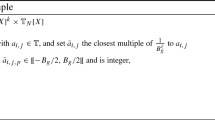Abstract
The secret key swap over protocol is developed using a Whale Optimization-guided Three Layer Neural Networks coordination mechanism in this article. An adversary can target crucial data while transferring confidential information via sniff, Man-In-The-Middle (MITM), phishing, or spoofing assault. Sensitive material must be delivered securely while adhering to the security hardening requirements of authentication, secrecy, and integrity. These criteria need the use of a secure protocol that is both end-to-end and resilient. For quicker coordination, this suggested technique uses a whale-guided optimization on the weights of the Triple Layer Tree Parity Machine (TLTPM). Because the optimum contributes to computational efficiency, a larger weight range might be considered to improve TLTPM safety. The difficulty of an effective assault grows exponentially as the weight spectrum is increased, whereas the efforts required to create the neural key reduces over polynomially. As a result, guessing the inner structure will be challenging for the adversary. The session key is the coordinated weight matrix. The suggested method allows for simultaneous coordination and verification. The adversary has a hard time distinguishing amongst coordination and verification stages. Various parameter tests have been run on the suggested method. The collected findings are evaluated, resulting in improved adjustments. The outcomes have proven to be efficient and sustainable. In respect of the reported outcomes in the study, evaluations of the procedure demonstrate efficacy.






Similar content being viewed by others
References
Abdalrdha, Z. K., Alqinani, I. H., & Abbas, F. N. (2019). Subject review: Key generation in different cryptography algorithm. International Journal of Scientific Research in Science, Engineering and Technology, 6(5), 230–240. https://doi.org/10.32628/ijsrset196550.
Chourasia, S., Bharadwaj, H. C., Das, Q., Agarwal, K., & Lavanya, K. (2019). Vectorized neural key exchange using tree parity machine. Security and Communication Networks, 2021, 3140–3145. https://doi.org/10.1155/2021/6680782.
Dolecki, M., & Kozera, R. (2015). The impact of the TPM weights distribution on network synchronization time. Computer Information Systems and Industrial Management, 9339, 451–460.
Dong, T., & Huang, T. (2020). Neural cryptography based on complex-valued neural network. IEEE Transactions on Neural Networks and Learning Systems, 31(11), 4999–5004. https://doi.org/10.1109/TNNLS.2019.2955165.
Gao, J., Yang, X., Jiang, Y., Song, H., Choo, K. K. R., & Sun, J. (2021). Semantic learning based cross-platform binary vulnerability search for IoT devices. IEEE Transactions on Industrial Informatics, 17(2), 971–979. https://doi.org/10.1109/TII.2019.2947432.
Hadke, P.P., Kale, S.G .(2016). Use of neural networks in cryptography: A review. In Proceedings of the 2016 world conference on futuristic trends in research and innovation for social welfare (Startup Conclave), pp. 1–4
Jeong, S., Park, C., Hong, D., Seo, C., & Jho, N. (2021). Neural cryptography based on generalized tree parity machine for real-life systems. Security and Communication Networks. https://doi.org/10.1155/2021/6680782.
Jo, M., Jangirala, S., Das, A. K., Li, X., & Khan, M. K. (2020). Designing anonymous signature-based authenticated key exchange scheme for IoT-enabled smart grid systems. IEEE Transactions on Industrial Informatics. https://doi.org/10.1109/TII.2020.3011849.
Karakaya, B., Gülten, A., & Frasca, M. (2019). A true random bit generator based on a memristive chaotic circuit: Analysis, design and FPGA implementation. Chaos, Solitons Fractals, 119, 143–149.
Liu, L., Miao, S., Hu, H., & Deng, Y. (2016). Pseudo-random bit generator based on non-stationary logistic maps. IET Information Security, 10, 87–94.
Liu, P., Zeng, Z., & Wang, J. (2019). Global synchronization of coupled fractional-order recurrent neural networks. IEEE Transactions on Neural Networks and Learning Systems, 30(8), 2358–2368.
Lu, Y., Huang, X., Dai, Y., Maharjan, S., & Zhang, Y. (2020). Blockchain and federated learning for privacy-preserved data sharing in industrial IoT. IEEE Transactions on Industrial Informatics, 16(6), 4177–4186. https://doi.org/10.1109/TII.2019.2942190.
Makkar, A., Garg, S., Kumar, N., Hossain, M. S., Ghoneim, A., & Alrashoud, M. (2021). An efficient spam detection technique for IoT devices using machine learning. IEEE Transactions on Industrial Informatics, 17(2), 903–912. https://doi.org/10.1109/TII.2020.2968927.
Mehic, M., Niemiec, H., Siljak, M., Voznak. (2020). Error reconciliation in quantum key distribution protocols. In Proceedings of the international conference on reversible computation, pp. 222–236
Niemiec, M., (2019). Error correction in quantum cryptography based on artificial neural networks. Quantum Information Processing, 18, 1–18. https://doi.org/10.1007/s11128-019-2296-4.
Niemiec, M., Mehic, M., Voznak. (2018). Security verification of artificial neural networks used to error correction in quantum cryptography. In Proceedings of the 26th tele- communications forum (TELFOR), pp. 1–4
NIST. (2020). NIST Statistical Test. http://csrc.nist.gov/groups/ST/toolkit/rng/stats_tests.html
Pal, S. K., Mishra, S., & Mishra, S. (2019). An TPM based approach for generation of secret key. International Journal of Computer Network and Information Security, 11(10), 45–50. https://doi.org/10.5815/ijcnis.2019.10.06.
Patidar, V., Sud, K. K., & Pareek, N. K. (2009). A pseudo random bit generator based on chaotic logistic map and its statistical testing. Informatica, 33, 441–452.
Protic, D. (2016). Vojnotehnicki glasnik. Neural Cryptography, 64(2), 483–495. https://doi.org/10.5937/vojtehg64-8877.
Rana, N., Latiff, M. S. A., Abdulhamid, S. M., & Chiroma, H. (2020). Whale optimization algorithm: A systematic review of contemporary applications, modifications and developments. Neural Computing and Applications, 32(20), 16245–16277. https://doi.org/10.1007/s00521-020-04849-z.
Rosen-Zvi, M., Kanter, I., & Kinzel, W. (2002). Cryptography based on neural networks analytical results. Journal of Physics A Mathematical and General, 35(47), L707–L713. https://doi.org/10.1088/0305-4470/35/47/104.
Ruttor, A., Kinzel, W., Naeh, R., & Kanter, I. (2006). Genetic attack on neural cryptography. Physical Review E. https://doi.org/10.1103/physreve.73.036121.
Ruttor, A., Kinzel, W., & Kanter, I. (2007). Dynamics of neural cryptography. Physical Review E. https://doi.org/10.1103/physreve.75.056104.
Dorokhin, Édgar Salguero, Fuertes, W., & Lascano, E. (2019). On the development of an optimal structure of tree parity machine for the establishment of a cryptographic key. Security and Communication Networks, 2019, 1–10. https://doi.org/10.1155/2019/8214681.
Sarkar, A. (2019). Multilayer neural network synchronized secured session key based encryption in wireless communication. International Journal of Artificial Intelligence, 8(1), 44–53. https://doi.org/10.11591/ijeecs.v14.i1.pp169-177.
Sarkar, A. (2021a). Deep Learning guided double hidden layer neural synchronization through mutual learning. Neural Processing Letters, 53, 1355–1384. https://doi.org/10.1007/s11063-021-10443-8.
Sarkar, A. (2021b). Generative adversarial network guided mutual learning based synchronization of cluster of neural networks. Complex and Intelligent Systems. https://doi.org/10.1007/s40747-021-00301-4.
Sarkar, A. (2021c). Secure exchange of information using artificial intelligence and chaotic system guided neural synchronization. Multimedia Tools and Applications, 80, 18211–18241. https://doi.org/10.1007/s11042-021-10554-3.
Sarkar, A., & Mandal, J. (2012). Swarm intelligence based faster public-key cryptography in wireless communication (SIFPKC). International Journal of Computer Science and Engineering Technology (IJCSET), 3(7), 267–273.
Sarkar, A., Khan, M. Z., Singh, M. M., Noorwali, A., Chakraborty, C., & Pani, S. K. (2021). Artificial neural synchronization using nature inspired whale optimization. IEEE Access, 9, 16435–16447. https://doi.org/10.1109/ACCESS.2021.3052884.
Shacham, L. N., Klein, E., Mislovaty, R., Kanter, I., & Kinzel, W. (2004). Cooperating attackers in neural cryptography. Physical Review E. https://doi.org/10.1103/physreve.69.066137.
Shishniashvili, E., Mamisashvili, L., & Mirtskhulava, L. (2020). Enhancing IoT security using multi-layer feedforward neural network with tree parity machine elements. International Journal of Simulation Systems Science and Technology, 21(2), 371–383. https://doi.org/10.5013/ijssst.a.21.02.37.
Teodoro, A., Gomes, O., Saadi, M., et al. (2021). An FPGA-based performance evaluation of artificial neural network architecture algorithm for IoT. Wireless Personal Communications. https://doi.org/10.1007/s11277-021-08566-1.
Acknowledgements
The author expressed deep gratitude for the moral and congenial atmosphere support provided by the Ramakrishna Mission Vidyamandira, Belur Math, India under the DBT STAR college scheme.
Funding
This research did not receive any specific grant from funding agencies in the public, commercial, or not-for-profit sectors.
Author information
Authors and Affiliations
Corresponding author
Ethics declarations
Conflict of interest
No conflict of Interest.
Additional information
Publisher's Note
Springer Nature remains neutral with regard to jurisdictional claims in published maps and institutional affiliations.
Rights and permissions
About this article
Cite this article
Sarkar, A. Faster Synchronization of Triple Layer Neural Network Using Nature Inspired Whale Optimization: A Key Exchange Protocol. Wireless Pers Commun 124, 683–713 (2022). https://doi.org/10.1007/s11277-021-09378-z
Accepted:
Published:
Issue Date:
DOI: https://doi.org/10.1007/s11277-021-09378-z




